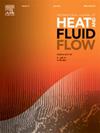液态金属GaInSn混合对流的实验研究
IF 2.6
3区 工程技术
Q2 ENGINEERING, MECHANICAL
International Journal of Heat and Fluid Flow
Pub Date : 2025-07-30
DOI:10.1016/j.ijheatfluidflow.2025.109995
引用次数: 0
摘要
混合对流对核快堆和核聚变包层的热水力特性具有重要意义。本研究采用常温下保持液态的GaInSn对液态金属混合对流进行了实验研究。试验断面为一截面积为50mm × 50mm,长度为3m的不锈钢风管。通过在实验系统上安装热电偶、流量计和差压传感器,可以在考虑流量和热流密度影响的情况下识别相应的流动和换热特性。结果表明,与强迫对流相比,混合对流的努塞尔数(Nu)随雷诺数(Re)的增加先减小后增大。Nu达到最小值时存在一个临界Rec, Rec随Grashof数(Gr)的增加而增大。这是由于浮力和切变力之间的竞争造成的流动分层、羽流扫掠和整体热滞留的结果,这可以用理查德森数(Ri)来描述。Nu随Ri的变化趋势表明,Ric的阈值在1左右。在Pe <时,获得了预测GaInSn混合对流Nu的经验相关性;1000. 流动方向上局部Nu的变化表明流动方向上存在混合对流的开始,功率谱密度进一步证实了这一点。本文章由计算机程序翻译,如有差异,请以英文原文为准。
Experimental study on mixed convection of liquid metal GaInSn
Mixed convection is of great importance for the thermal–hydraulic characteristics of nuclear fast reactors and nuclear fusion blankets. In the present study, the liquid metal mixed convection is experimentally studied by adopting GaInSn, which remains in a liquid state at room temperature. The test section is a duct with a cross-area of 50 mm × 50 mm and a length of 3 m made of stainless steel. By installing the thermocouples, flow meter, and differential pressure transducers on the experimental system, the corresponding flow and heat transfer characteristics can be identified with considering the influence of flow rate and heat flux density. The present results show that, compared to forced convection, the Nusselt number (Nu) of mixed convection decreased first and then increased with the increase of Reynolds number (Re). There exists a critical Rec when Nu reaches a minimum value, and Rec increases with the increase of the Grashof number (Gr). It is a consequence of flow layering, plume sweeping, and bulk heat entrapment, due to the competition between buoyancy and shear forces, which can be described by the Richardson number (Ri). The change tendency of Nu as a function of Ri indicates that the threshold value of Ric is around 1. An empirical correlation is obtained to predict Nu for GaInSn mixed convection when Pe < 1000. The variation of the local Nu in flow direction indicates the existence of the onset of mixed convection in the flow direction, which is further confirmed by the power spectral density.
求助全文
通过发布文献求助,成功后即可免费获取论文全文。
去求助
来源期刊

International Journal of Heat and Fluid Flow
工程技术-工程:机械
CiteScore
5.00
自引率
7.70%
发文量
131
审稿时长
33 days
期刊介绍:
The International Journal of Heat and Fluid Flow welcomes high-quality original contributions on experimental, computational, and physical aspects of convective heat transfer and fluid dynamics relevant to engineering or the environment, including multiphase and microscale flows.
Papers reporting the application of these disciplines to design and development, with emphasis on new technological fields, are also welcomed. Some of these new fields include microscale electronic and mechanical systems; medical and biological systems; and thermal and flow control in both the internal and external environment.
 求助内容:
求助内容: 应助结果提醒方式:
应助结果提醒方式:


